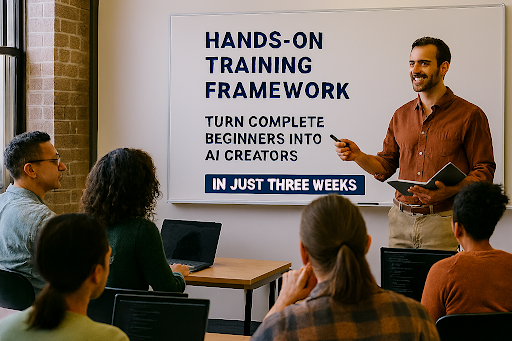
The race to create smarter machines is going at lightning speed, with millions of young people fearing to be left behind. This is not for the lack of curiosity, but as access to cutting-edge technology feels out of reach. The skill gaps are the greatest hurdles to business development for 63% of employers worldwide, and almost 40% of core job skills will shift by 2030 as artificial intelligence takes charge. The difficulty is especially acute in AI, as demand for skilled workers is three times higher than supply, making industries from healthcare to retail struggle to maintain balance. Against this backdrop, a fresh approach is helping underrepresented students enter the field of generative AI, giving them the opportunity to shape mechanisms that could change everything from drug discovery to personalized shopping.
A Framework Built for Inclusion
At the center of this initiative is Srinivasa Atta, staff solutions consultant at a leading tech firm. He developed a hands-on training framework that can turn complete beginners into capable Generative AI creators in just three weeks.
Partnering with Break Through Tech, a nonprofit advancing gender equity in computing, Srinivasa designed the program to train undergraduate students from underrepresented groups. In this 3-week challenge project, instead of classroom lectures, participants jump straight into real-world challenges on platforms like Vertex AI, devising solutions that imitate enterprise use cases, everything from generating synthetic data to deploying operating models.
With generative AI exploding since tools like ChatGPT went mainstream in 2022, and global AI spending is projected to exceed $200 billion by 2025, the need for such programs is evident. Still, many companies are struggling to find people who can apply AI responsibly.
Representation gaps make things worse. Only 27% of the tech workforce is female, and in AI roles the number drops to 22%. That lack of diversity limits advancement in crucial areas like bias detection, which affects everything from loan approvals to online advertising.
How the Framework Works
Srinivasa Atta’s model takes a different route from long, drawn-out training programs. Each cycle starts with a practical problem, for instance, analyzing customer sentiment in e-commerce data, and walks students through data preparation, model training, and deployment.
The framework includes curated datasets and step-by-step manuals, cutting down the trial-and-error that often overwhelms beginners. Then comes proof-of-concept projects like AI agents for inventory forecasting, which students pitch to industry leaders at the end. Lastly, it provides a built-in focus on ethical AI, including fairness audits and inclusive problem-solving.
For example, one team trained an AI agent to manage multilingual customer queries, which is a vital skill for global e-commerce. Others worked on projects that mirror real retail challenges, such as optimizing supply chains to reduce waste.
Beyond Skills: Building Equity
The program doesn’t just upskill, but it answers inequality. Women from minority backgrounds in computing still earn 20% less than peers despite equal qualifications. By targeting these groups, Srinivasa Atta’s framework opens opportunities to well-paying tech careers while also making AI systems more representative.
The results are impactful, where in pilot runs every team produced working prototypes. Also, the initiative expanded to eight U.S. sites in 2025, training dozens more students. The Break Through Tech reports highlighted that nearly 1,000 women landed tech jobs after similar programs, with 96% of computer science graduates earning over $70,000 in their first role.
A Scalable Global Blueprint
This approach is not limited to the U.S., as with cloud-based tools, this blueprint avoids the need for high-end hardware, making it suitable for global rollout. That aspect is crucial as AI adoption expands in regions like Africa, where the market is expected to grow 28% yearly through 2030 according to McKinsey estimates. This ultimately proves advantageous for industries, as the manufacturing sector can apply these skills for predictive maintenance, lowering costly downtime; retail can optimize stock levels across borders, preventing shortages in one region while cutting waste in another. This framework offers job-ready skills in weeks to the students, reflecting the pace of international business where delays in training can cost millions.
New challenges are always showing up, like unequal starting points in coding skills or limited access to computing resources. To address this, the program integrates mentorship from seasoned professionals, turning potential setbacks into learning opportunities. As Srinivas Atta puts it: “It is widely accepted that proficiency in complex cloud-based AI platforms takes months, if not years. My model proves that with a carefully designed curriculum and hands-on guidance, foundational competence can be achieved in just three weeks.”
AI is becoming an integral part of our everyday life; from diagnosing illnesses to curating news feeds. Biases will persist, if only a narrow slice of society builds these tools. The framework developed by Srinivasa Atta offers a clear path forward with fast, inclusive, and practical training that equips overlooked talent to shape the future of AI.
More diverse teams mean better AI, with systems that recognize cultural nuance, serve underserved communities, and drive fairer outcomes in healthcare, finance, and retail. By investing in this pipeline today, we create a tomorrow where advancements are not gated by background, but supported by it.



